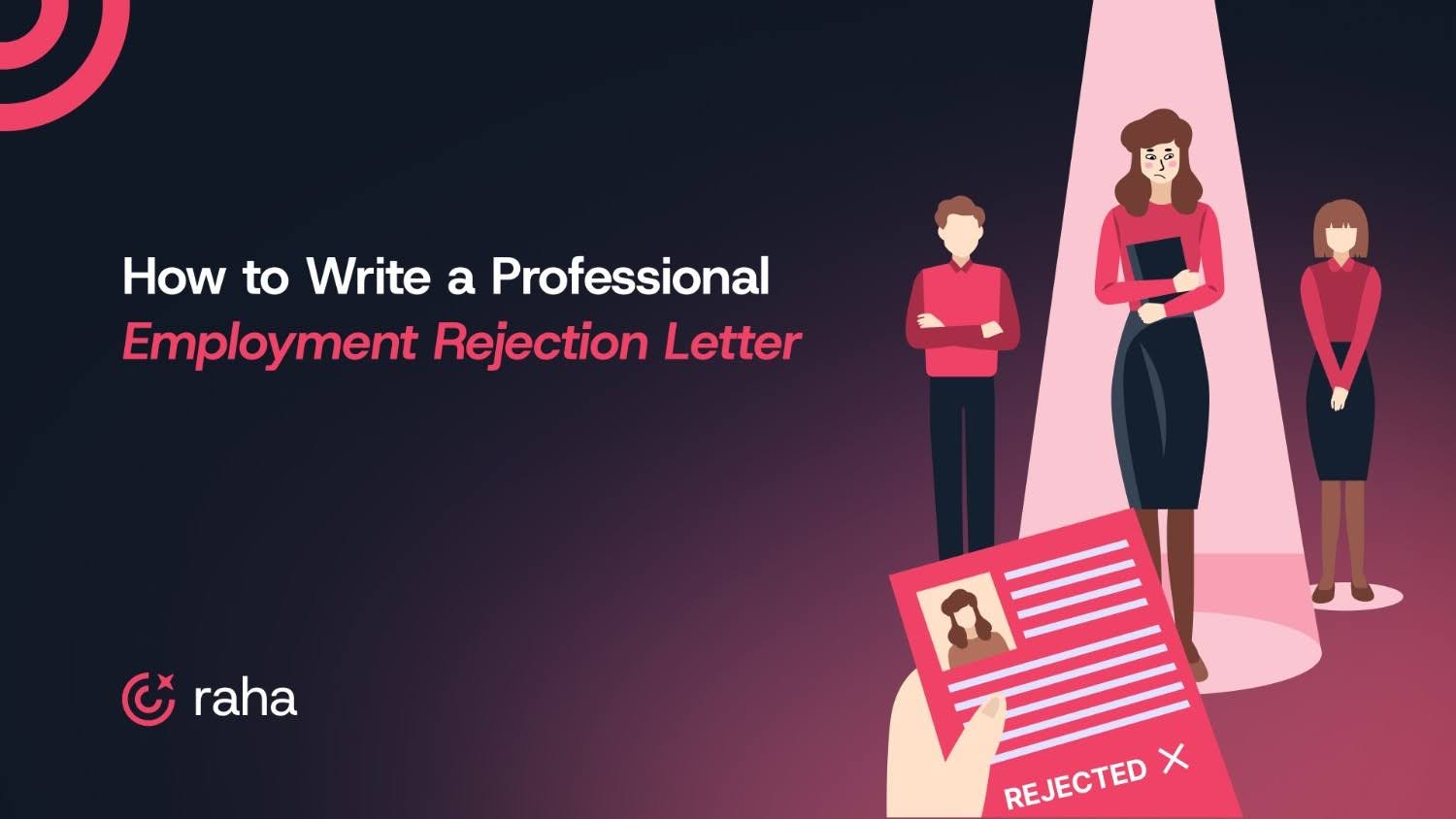
Most candidates never hear back after applying. In fact, 65% of candidates say they rarely receive an update at all, and when they do, over half wait more than three months.
That kind of delay hurts future hiring.
When candidates don’t hear back, 80% of them won’t consider applying to other open roles at your company. On the other hand, candidates who are clearly notified of their outcome are 3.5x more likely to reapply in the future.
Writing a solid employment rejection letter is one of the simplest and most overlooked ways to improve your candidate experience. It shows respect, closes the loop, and keeps your brand intact.
Here’s how to do it right with practical examples you can actually use.
Key Takeaways:
- An employment rejection letter provides clarity and closure, ensuring candidates aren’t left wondering about their status.
- Tone matters. Respectful, personalized rejections maintain your employer brand and candidate relationships.
- Timing is key. Prompt communication, especially after interviews, builds trust and professionalism.
- Rejections should match the stage of the process, with more thoughtfulness given to late-stage or internal candidates.
- Templates help scale rejections, but the best ones still sound human and leave the door open when appropriate.
What Is an Employment Rejection Letter?
An employment rejection letter is a formal message sent to a candidate to inform them they have not been selected for the role they applied for. It’s usually sent after interviews, but it can (and should) be sent after any stage where a candidate is disqualified.
It answers:
- Has the position been filled?
- Were they still in the running?
- Should they expect feedback or closure?
- Can they reapply or be considered in the future?
At its core, the rejection letter creates clarity. It gives candidates closure, reduces ghosting complaints, and protects your hiring reputation, especially with top-tier applicants you might want to re-engage later.
And here’s the part that’s often missed:
When done well, it leaves a positive impression and keeps the door open for future opportunities.
How to Write a Respectful and Professional Rejection Letter
A well-written rejection letter preserves your employer brand while maintaining a respectful candidate experience, especially for those who may reapply or refer others in the future.
Here’s how to get it right:
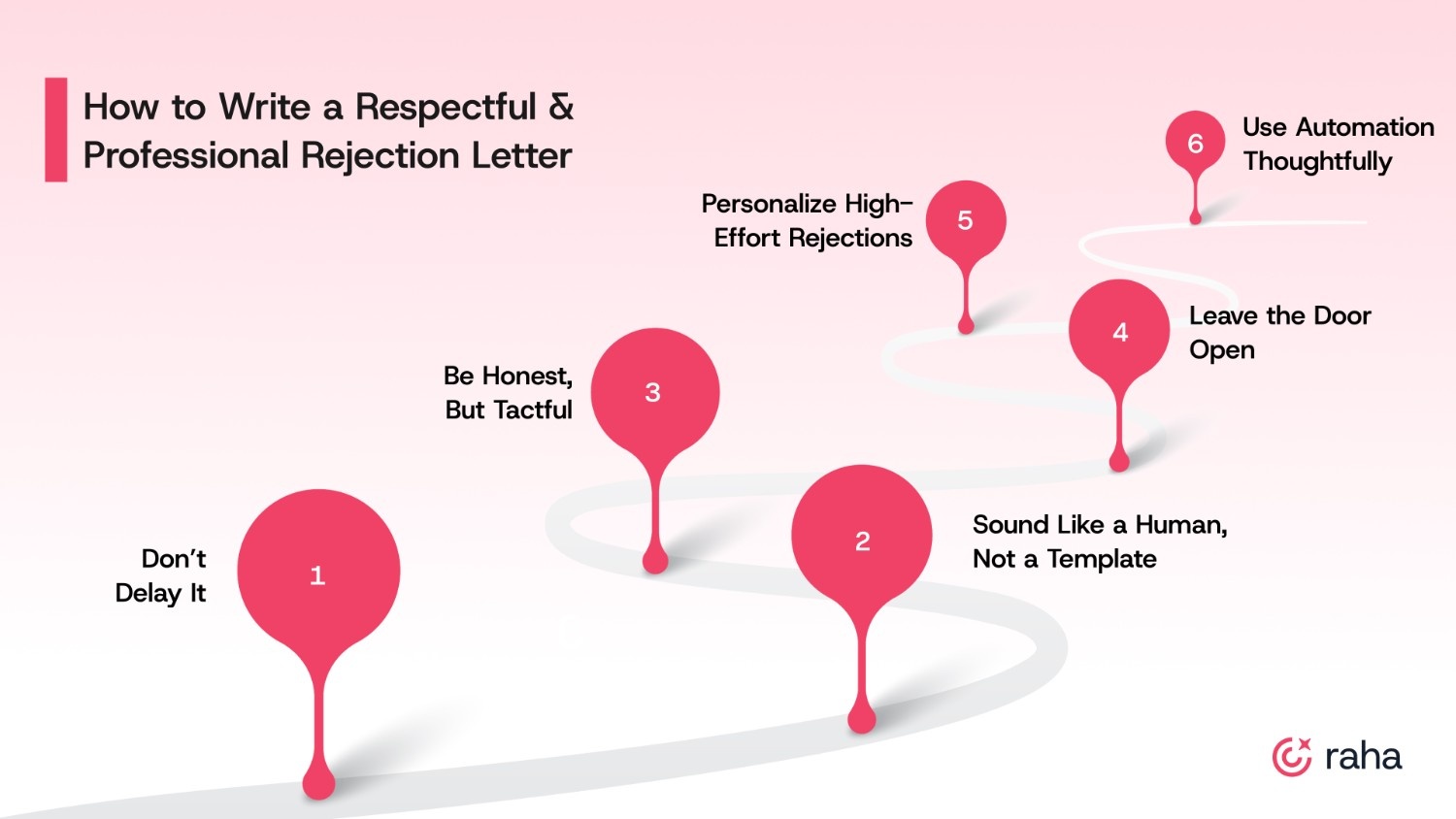
1. Don’t Delay It
The longer you wait, the more you damage trust. Candidates are often juggling multiple interviews or are emotionally invested in your process. If someone is clearly not moving forward, let them know promptly.
What to do:
- For early-stage rejections, aim for within 48–72 hours post-screening.
- For final-round rejections, notify the same day or the next day, ideally with a quick call followed by an email.
Why it matters: Timely closure shows respect and reduces candidate ghosting in future pipelines.
2. Sound Like a Human, Not a Template
Avoid templates that sound like they were written by legal. Even a short rejection can feel thoughtful if it sounds like it came from a human, not a bot.
What to include:
- Use the candidate’s name.
- Acknowledge the effort they put into the process.
- Mention the specific role they applied for.
Example opening:
“Thank you again for taking the time to interview for the [Job Title] role with us. We truly appreciated learning about your background and experience.”
3. Be Honest, But Tactful
You don’t need to over-explain, but vague phrases like “we’ve gone in another direction” help no one. Offer a concise reason if appropriate, especially for final-round candidates.
What you can say:
- “We were impressed by your experience, but we’re looking for someone with deeper experience in [specific skill/domain].”
- “At this time, we’ve chosen a candidate with more direct industry exposure.”
Avoid critiques of personality or culture fit. These often come across as biased or dismissive.
4. Leave the Door Open (When It’s True)
If you genuinely see potential for future roles, say so, and make sure it’s not just lip service.
What to do:
- Mention the possibility of keeping in touch.
- Add them to a talent pool or silver medalist list in your ATS.
- Invite them to follow your careers page or connect on LinkedIn.
Example line:
“We were impressed by your potential and would love to stay in touch about future opportunities.”
5. Personalize High-Effort Rejections
If someone spent 4+ hours interviewing, consider a more tailored note, even if the format is still an email.
Best practice:
- Mention something they shared that stood out.
- Acknowledge specific contributions (e.g., case studies, take-home tasks).
- Offer a brief note of encouragement or appreciation.
Example:
“Your approach to the [presentation/exercise] showed clear strategic thinking. We truly appreciated the time and thought you put into it.”
6. Use Automation Thoughtfully
For volume roles, automation is necessary. But it doesn’t have to feel impersonal.
What helps:
- Use conditional logic to tailor based on stage (e.g., auto-reject for pre-screens vs. post-onsite).
- Always include the candidate’s name and role title.
- Avoid sending rejections in the middle of the night—it feels off.
Every rejection is a brand touchpoint. Done well, it leaves candidates thinking: “They passed on me, but they did it with respect.” And that can make all the difference.
Also read: What is Candidate Relationship Management? Key Steps, Challenges & Tools
Candidate Rejection Letter Templates (With Examples)
Rejections don’t need to be over-engineered, but they should always be respectful, clear, and tailored to the stage of the hiring process. Below are ready-to-use templates for different points in the candidate journey. Whether you're rejecting after a resume screen or a final-round call, these will help you communicate professionally and keep the door open for future engagement.
1. Application Rejection (Before Any Contact)
This is the earliest stage, when a candidate applies but isn’t shortlisted. They haven’t spoken to anyone yet. A simple, timely rejection here goes a long way in preserving the employer brand. It shows respect for their effort, even if you didn’t engage further.
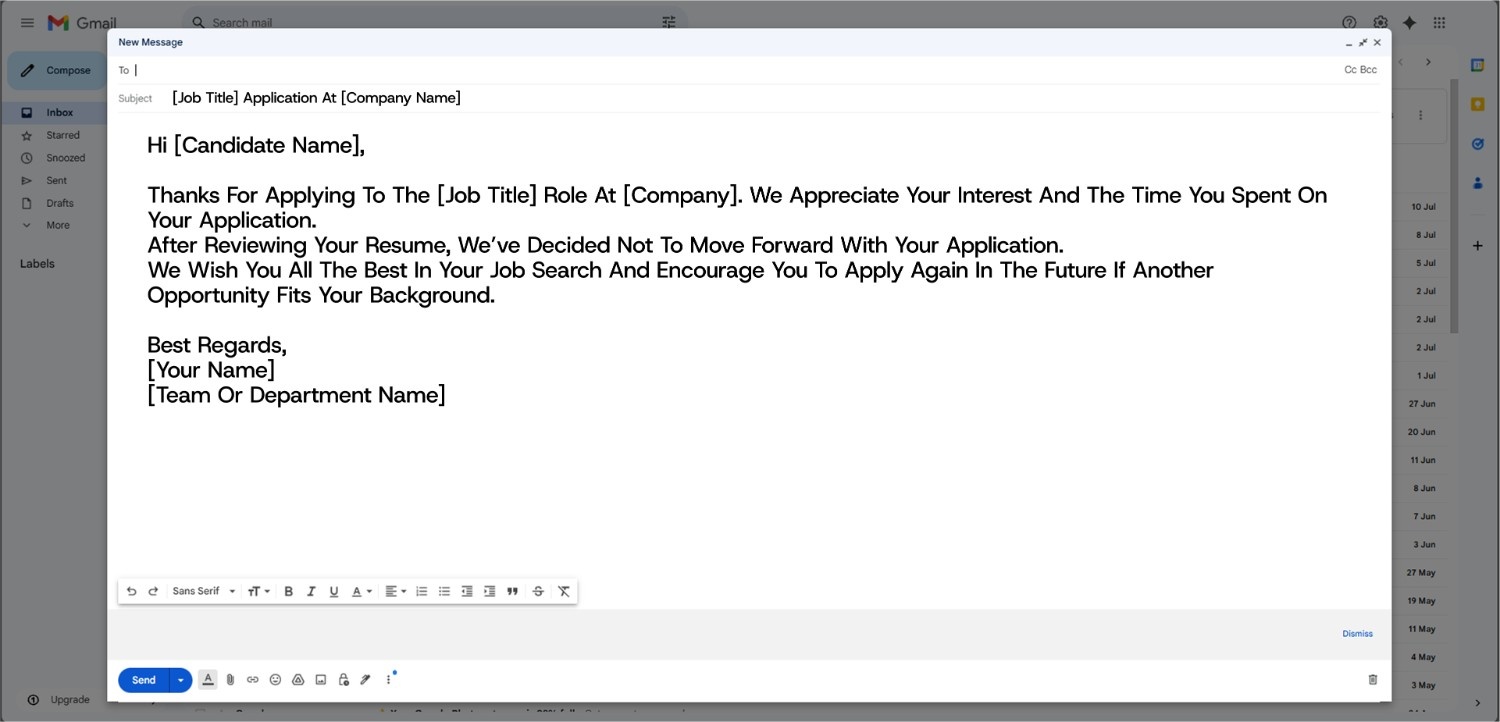
Subject: [Job Title] Application at [Company Name]
Hi [Candidate Name],
Thanks for applying to the [Job Title] role at [Company]. We appreciate your interest and the time you spent on your application.
After reviewing your resume, we’ve decided not to move forward with your application.
We wish you all the best in your job search and encourage you to apply again in the future if another opportunity fits your background.
Best regards,
[Your Name]
[Team or Department Name]
2. Screening Stage Rejection (After Phone Screen or Assessment)
At this point, the candidate has had a touchpoint with your team, maybe a recruiter screen or a take-home task. They’ve invested more and likely expect some form of feedback. Keep it polite and prompt, and offer one line of context if possible to personalize the note.
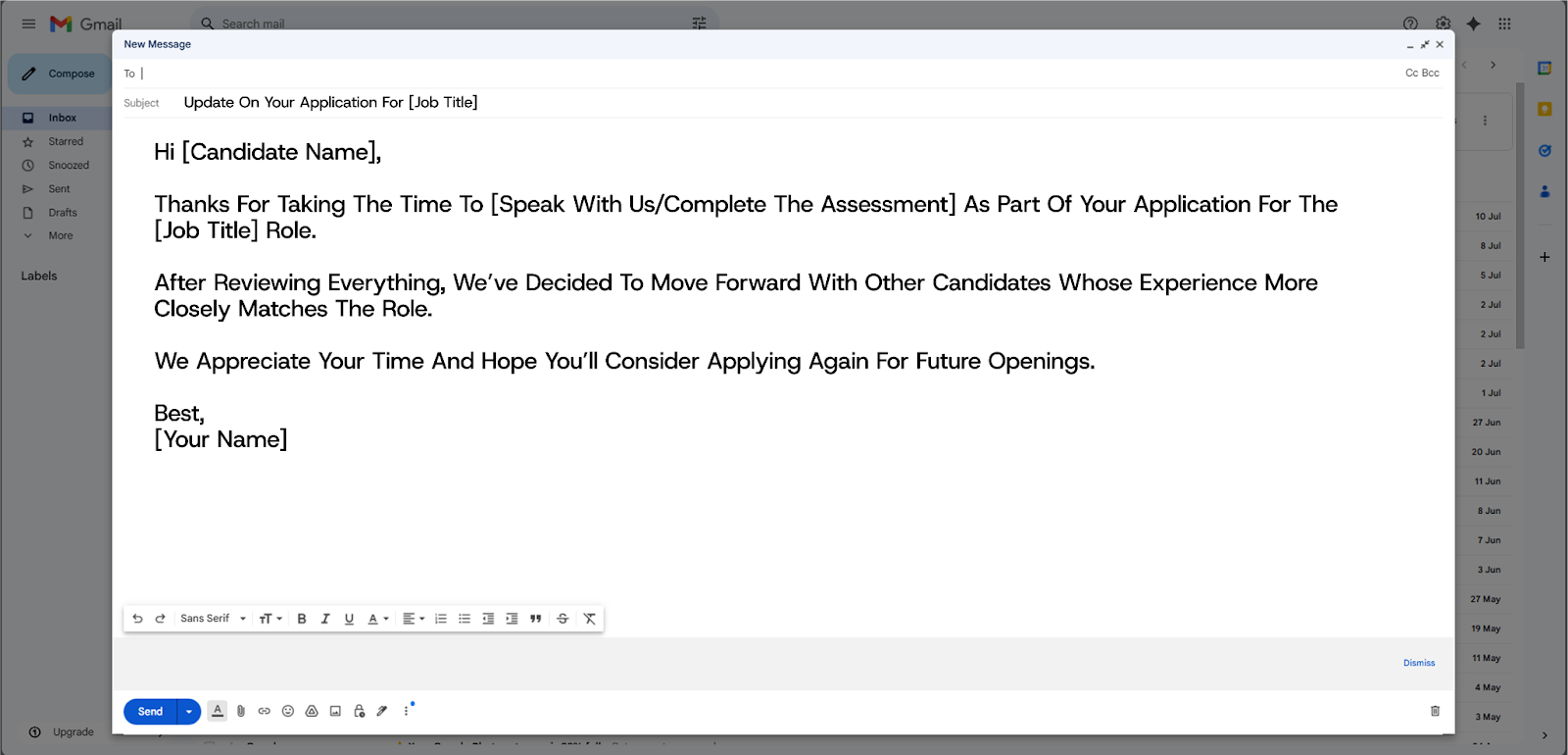
Subject: Update on Your Application for [Job Title]
Hi [Candidate Name],
Thanks for taking the time to [speak with us/complete the assessment] as part of your application for the [Job Title] role.
After reviewing everything, we’ve decided to move forward with other candidates whose experience more closely matches the role.
We appreciate your time and hope you’ll consider applying again for future openings.
Best,
[Your Name]
How can this be avoided with Raha AI?
Most candidate drop-offs and poor experiences happen here. It’s either due to inconsistent screening, unclear criteria, or delays in follow-up.
Raha AI helps you solve for all three.
Its AI Resume Screener identifies the most relevant candidates upfront using skills-based signals, not just keywords. Then, Raha’s AI Interviewer gives every candidate the same first-round experience, scoring them on structured responses and highlighting those with real fit.
You reduce bias, save time, and only advance the candidates who genuinely match the role. That means fewer rejections later and better candidate experiences throughout.
3. Rejection After a Phone Interview or Call With Hiring Manager
This is a deeper stage, often after one or more interviews. The candidate has started to visualize themselves in the role. Your rejection should reflect that. This should be a more thoughtful message that acknowledges their effort and encourages future connection.
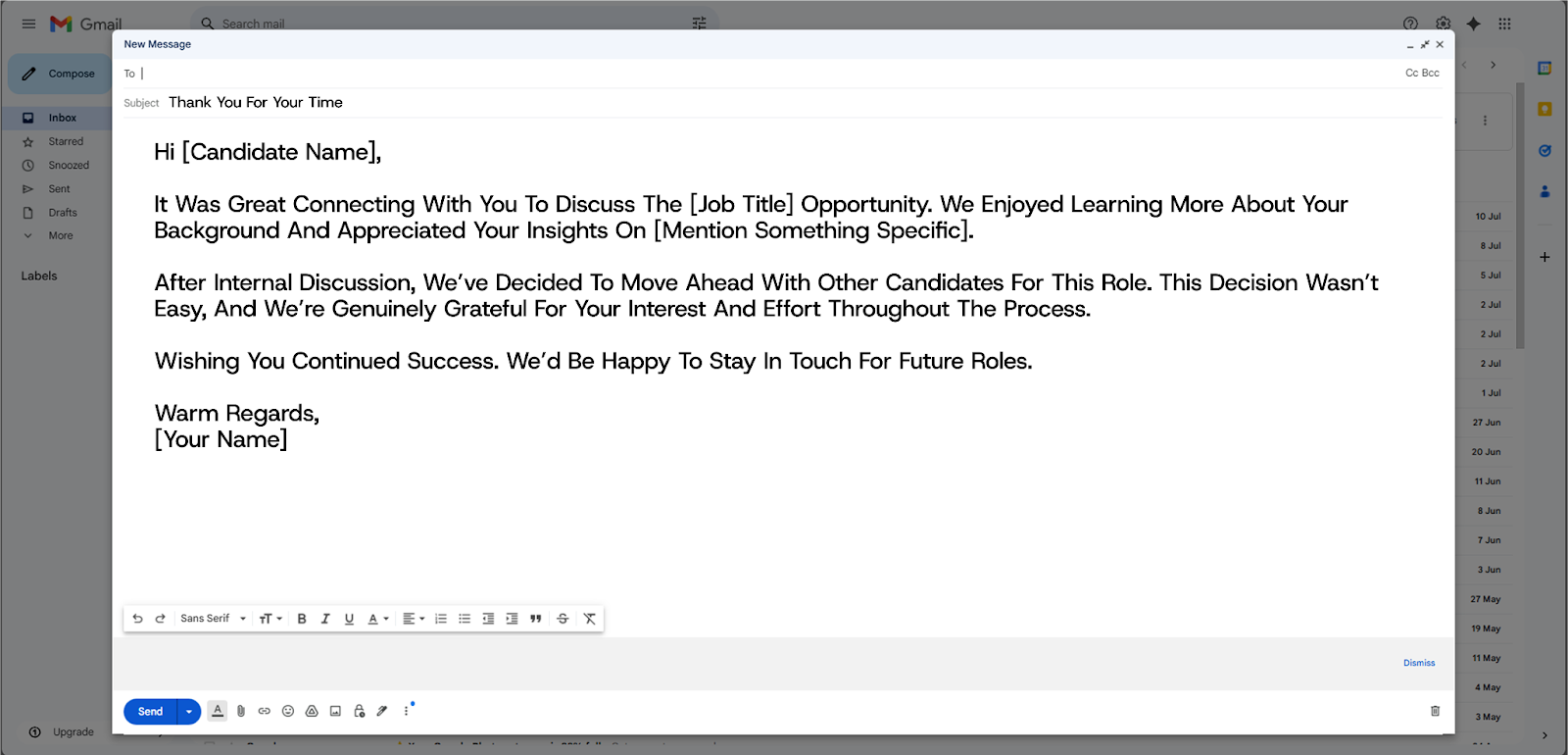
Subject: Thank You for Your Time
Hi [Candidate Name],
It was great connecting with you to discuss the [Job Title] opportunity. We enjoyed learning more about your background and appreciated your insights on [mention something specific].
After internal discussion, we’ve decided to move ahead with other candidates for this role. This decision wasn’t easy, and we’re genuinely grateful for your interest and effort throughout the process.
Wishing you continued success. We’d be happy to stay in touch for future roles.
Warm regards,
[Your Name]
4. Final Round Rejection
Use this when the candidate has gone through multiple rounds or panel interviews. It should reflect appreciation for their time and the depth of the process.
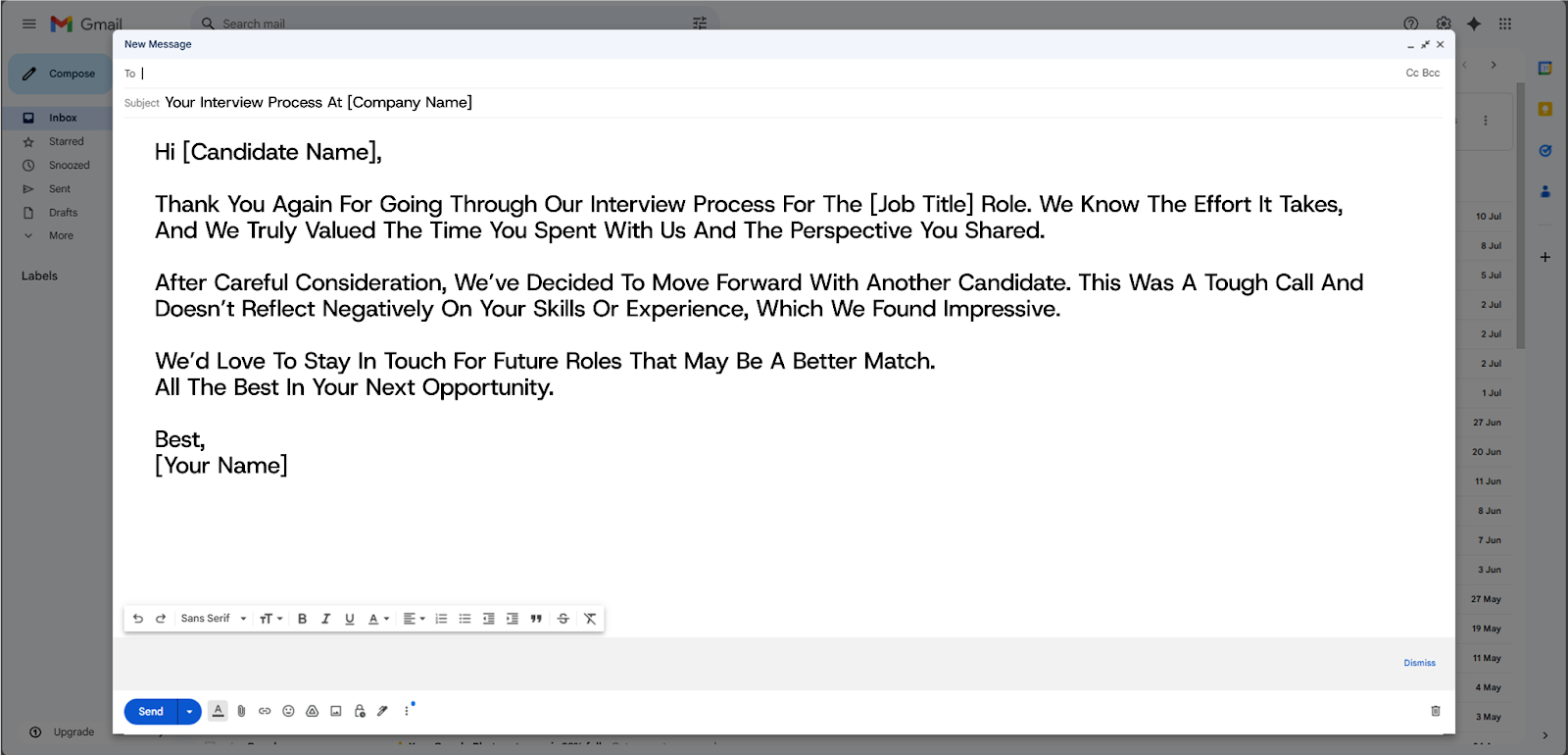
Subject: Your Interview Process at [Company Name]
Hi [Candidate Name],
Thank you again for going through our interview process for the [Job Title] role. We know the effort it takes, and we truly value the time you spent with us and the perspective you shared.
After careful consideration, we’ve decided to move forward with another candidate. This was a tough call and doesn’t reflect negatively on your skills or experience, which we found impressive.
We’d love to stay in touch for future roles that may be a better match.
All the best in your next opportunity.
Best,
[Your Name]
5. Post-Call Follow-Up Rejection (After Verbal Feedback)
Sometimes, you deliver the decision live through a phone call or Zoom. But even after a personal conversation, it’s best practice to follow up in writing. It gives the candidate something to refer back to and reinforces the closure.
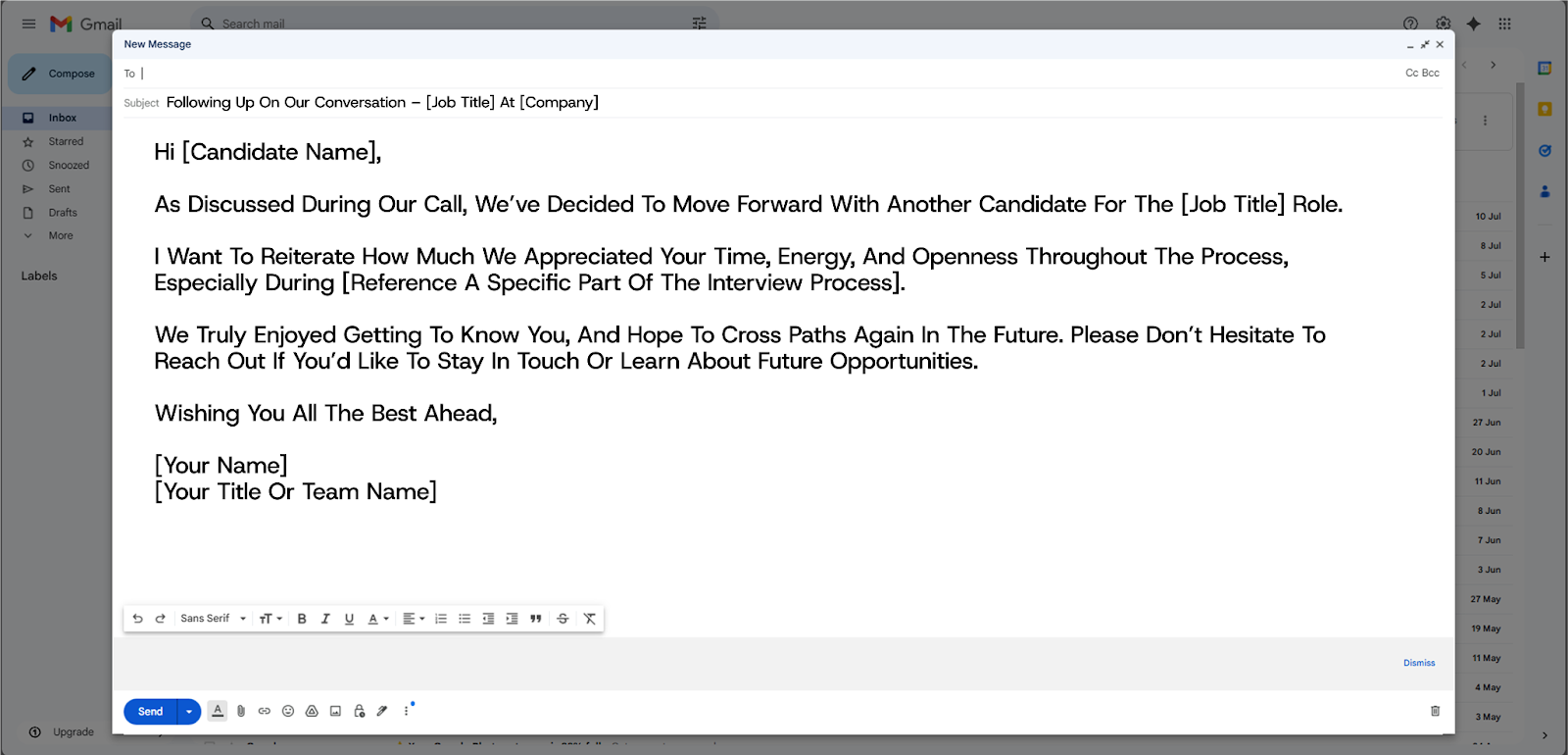
Subject: Following Up on Our Conversation – [Job Title] at [Company]
Hi [Candidate Name],
As discussed during our call, we’ve decided to move forward with another candidate for the [Job Title] role.
I want to reiterate how much we appreciated your time, energy, and openness throughout the process, especially during [reference a specific part of the interview process].
We truly enjoyed getting to know you and hope to cross paths again in the future. Please don’t hesitate to reach out if you’d like to stay in touch or learn about future opportunities.
Wishing you all the best ahead,
[Your Name]
[Your Title or Team Name]
Also read: How to Conduct Online Interviews Successfully? Steps & Strategies
Screen Smarter to Build a More Candidate-Respectful Process
The hardest part about writing a rejection letter isn’t the message. It’s being sure you’re making the right call.
That starts with better screening.
You now have clear templates and tips to handle rejections at every stage. But even the most respectful message won’t land well if the decision behind it feels rushed or uncertain.
Raha AI helps you avoid that by identifying strong-fit candidates from the start, and AI-led interviews uncover real signals on skills and intent.
Connect with us and see how Raha AI fits into your hiring process.
FAQs
1. What should be included in an employment rejection letter?
A strong rejection letter includes a clear message that the candidate was not selected, a thank-you for their time, and a professional closing. You may also choose to briefly reference the evaluation process or invite them to apply again in the future, if appropriate.
2. What is the best way to deliver a rejection after an interview?
Email is acceptable for early-stage rejections, like resume or screening disqualifications. For candidates who went through live interviews, a phone call followed by a written message is more respectful. It shows you value the effort they put into your process.
3. How soon should you send a rejection letter following an interview?
The best practice is to respond within one to three business days of making your decision. Prompt communication prevents candidates from waiting unnecessarily and reflects well on your hiring experience.
4. Is it appropriate to provide feedback in a rejection letter?
For early stages, feedback is optional. But for candidates who reached the final rounds, short and constructive feedback is often appreciated. If you choose to share it, make sure the tone is respectful and the guidance is specific.

